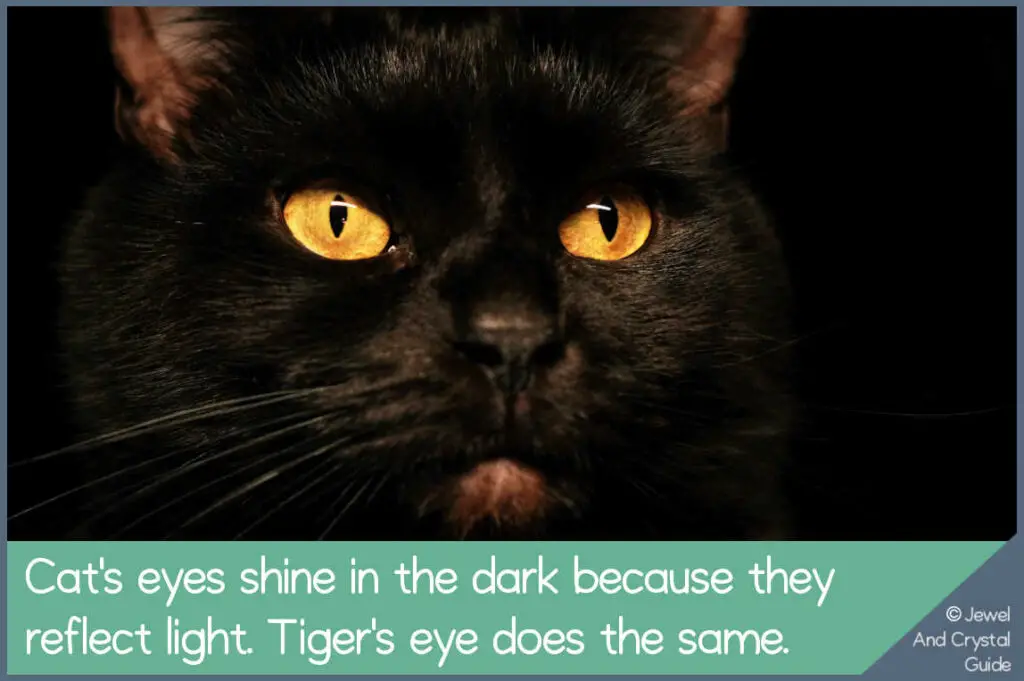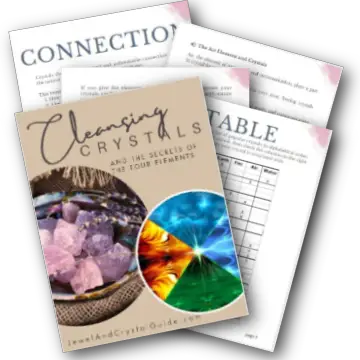You’re probably here because you’re wondering if a crystal you have is real tiger’s eye or not. The good news is that there are ways to tell if it’s a fake.
Below I give all the info you need to help you discover if your crystal is genuine or not…
In this post, you’ll get 13 methods to test if a crystal is real tiger’s eye or an imitation.
Real tiger’s eye…
Weighs about 2.7 in water
A great way to tell if tiger’s eye is real is to measure its specific gravity or density. A crystal’s density is how much space it takes up when it’s dropped into water.
The specific gravity or relative density of tiger’s eye is between 2.64 and 2.71 (source). I’ll give you an easy way to measure this below.
What you need to measure a tiger’s eye’s specific gravity:
- A scale that goes up to one or two decimal places, like this one that I use
- A container
- A pen and a piece of paper
Here’s how to determine the specific gravity of a tiger’s eye crystal:
- Weigh the container you’ll be using for this measurement. Write down the weight up to two decimal places. Make sure the container is large enough to hold some water and the crystal you are testing. This is your first measurement.
- Add water to the container and weigh it again, writing down the number up to two decimal places. This is your second measurement.
- Add the crystal to the water and write down the weight to two decimal places. This is your third measurement.
- Subtract the weight of the empty container (first measurement) from the weight of the water-filled container (second measurement) and then subtract it from the water and crystal weight (third measurement). You now have the true weights of the water and the water and crystal, so these are the weights without the container.
- Divide the true weight of the crystal and water weight by the true weight of the water-only weight. This gives you the crystal’s specific gravity or relative density.
- If the specific gravity is between 2.64 and 2.71, then you have a real tiger’s eye in your hand. If the specific gravity reading is 2.63 or less, it’s probably a fake glass crystal.
Weighs more than glass
Closely related to specific gravity above, real tiger’s eye is heavier than glass (which is why its specific gravity or relative density is higher than glass).
In plain English, real tiger’s eye has a solid heavy feel to it and weighs more than glass, especially when comparing large crystals.
If you hold two crystals of a similar size in your hands or put them on a digital scale, a fake crystal usually weighs less or feels lighter than a real crystal because the fake is probably made from glass.

Has different shades of brown
There are many different colored quartzes and the name tells you what color the quartz is. For example, amethyst is purple quartz and rose quartz is pink.
Tiger’s eye is brown. Each stone comes in banded shades of brown – from lighter golden yellow browns or even reddish browns, to a brown that’s so dark, it’s almost black.
Quartz with these colors is called tiger’s eye or sometimes something else depending on what color it is – click here to find out what colors there are, what they’re called, and what gives them these colors.
The coloring and shine on the crystal depends a lot on where it was mined. Click here to find out where tiger’s eye comes from and what each country’s tiger’s eye looks like.
If you hold several pieces of tiger’s eye next to each other, especially if you got them at different times or from different places, you’ll see that the shades of brown vary quite a bit, with some pieces being darker or lighter than others, and each having its own pattern.
Real tiger’s eye is never one solid color, unless it’s a very small piece taken from one color area of a bigger piece. But this is quite rare. If the coloring is the same throughout your crystal, it might be glass that was dyed in a factory.
Sometimes tiger’s eye comes in red or blue tones. Red tiger’s eye is also called ox’s eye, and blue tiger’s eye is referred to as hawk’s eye.
You can use the same methods in this post to tell if red or blue tiger’s eye is real, except the colors will be different. Red tiger’s eye has red bands in it, not shades of brown, and blue tiger’s eye is streaked blue.
Is chatoyant, which makes it like a cat’s eyes
If you look at real tiger’s eye, you’ll notice lines running through it. And if you move the stone in the light, it looks like there’s a bright line of light moving along the stone.
This band glows like a cat’s eye in a light at night, which is one of the reasons why tiger’s eye is called tiger’s eye.
It does this because real tiger’s eye has a special property called chatoyancy, which means that it reflects more light than it absorbs. You can read all about chatoyancy and why tiger’s eye shines in this blog post.

Fake tiger’s eye doesn’t have this quality, so it cannot reflect light like a real tiger’s eye does.
Sparkles with glitter-like diamonds
Some tiger’s eye stones – not all of them – sparkle in the light. It almost looks as though there are tiny little diamonds or pieces of silver glitter scattered across the crystal.
If you see these sparkles, then your crystal is most likely real and not a fake.
Has random patterns
Real tiger’s eye never has perfectly straight lines in it – they’re always uneven and the colors often bleed into each other.
If a crystal has perfectly straight lines or an obvious pattern, there’s a chance it’s fake. And if there are visible bubbles or hollow spots inside, it’s most likely glass with air bubbles from the manufacturing process.
If you look at several tiger’s eye crystals from the same seller, the patterns should all look different. If some of the stones look exactly same, like carbon copies of each other, there’s a chance they aren’t real.
Never has a raised mold line on its surface
Real tumbled tiger’s eye crystal is perfectly smooth, without any markings or raised lines on it. Real raw tiger’s eye has an irregular and rugged surface, but never any straight raised lines across it.
Fake tiger’s eye crystal that’s made from glass sometimes has a raised line or visible marking on it from the mold used to make it. This is usually the case in jewelry or smaller decorative pieces.
If you want to know what sort of line to look for, feel a glass mug. You should find a raised line running vertically, from top to bottom, along one side of the cup, often by the handle. This line is from the mold that shaped the glass into a mug.
Can be tumbled
Real tiger’s eye can be tumbled into a smooth, smaller crystal, but fake glass quartz shatters when tumbled.
If you have a piece of quartz and you’re wondering if it’s real, try tumbling it yourself if you aren’t worried about destroying it.
Tumbling is done by putting a crystal into a machine, such as this hobby tumbler from Amazon, that rolls the crystal around with rough rocks. As the rocks and crystal roll around together, the rocks remove the crystal’s rough edges, making it smooth.
If your crystal survives tumbling, it’s real. If your crystal breaks into pieces or shatters when tumbled, it’s fake.
Cannot be scratched with steel
The Mohs scale measures how hard minerals are. This scale runs from 1 to 10, with 1 being the softest (talc) and 10 being the hardest (diamonds).
Items on the Mohs scale are ranked above all the things that are softer than them and below all the things that are harder than them.
Real tiger’s eye is quartz, which is ranked number 7 on the Mohs scale. This means it’s softer than topaz, corundum, and diamonds. Any of these minerals can scratch a tiger’s eye, but they would also scratch a fake tiger’s eye made from glass because they’re harder than glass too.
The trick to telling a real tiger’s eye from a fake is to try scratching the crystal with a steel nail or a steel knife. If the steel leaves a mark, the crystal is probably an imitation. If the steel leaves no mark, it’s probably real.
This is because steel is softer than quartz but harder than glass on the Mohs scale.
Can scratch steel
According to the Mohs scale, real tiger’s eye is harder than steel.
To test if a tiger’s eye crystal is real, scratch something made from steel, such as a steel knife, a watch casing, or even a steel file.
If the crystal leaves scratch marks, even tiny ones, then it’s real quartz. You might need to look for scratches through a magnifying glass to see them properly.
Is about the same price, no matter where you buy it
Crystal sellers buy crystals from suppliers. There are a limited number of tiger’s eye suppliers, and their prices are all very similar. So all crystal sellers are paying about the same price for tiger’s eye.
Sellers have to sell these crystals for more than what they paid for them, if they want to make a profit. So you’ll find that crystal sellers generally sell tiger’s eye for about the same price – their supplier’s price plus a markup for profit.
If you find tiger’s eye that’s on sale for a price that’s too good to be true (much, much cheaper than other sellers), there’s a chance it’s fake.
Exceptions might be for online stores that have less costs to cover than brick-and-mortar stores, and stores that are closing down and trying to get rid of stock.
Comes from a trustworthy seller
If you buy tiger’s eye from a seller that you know you can trust, and that seller tells you the quartz is real, then it probably is.
Below are some things you can do to make sure the tiger’s eye is real:
- Do some online research about the seller, to look for bad reviews or complaints that other people might have made. You can also speak to others or join Facebook groups and ask for recommendations.
- Check the seller’s website to see what information they give and if they look authentic.
- Ask the seller to provide proof of where they got the tiger’s eye from. Most tiger’s eye comes from South Africa, but it’s also mined in Australia, Burma, India, the US, Brazil, Canada, and China.
- Buy tiger’s eye jewelry that is certified by the Gemological Institute of America (GIA) or the gem certification body in your country.
Can be confirmed by a professional
If you really need to know if a crystal is real tiger’s eye or not, and none of the above methods give a definitive answer, ask a professional crystal dealer, lapidist, or appraiser to take a look.
A professional will have the tools, knowledge, and experience to confirm if a tiger’s eye crystal is real or not. However, yellow tiger’s eye is fairly common and is not a very expensive crystal, so it is not really worth making fake stones to sell and fake tiger’s eye is not a widespread problem.
Blue and red tiger’s eyes are rarer, so these are more expensive.
As a general rule of thumb, your crystal is more likely to be real than fake.











